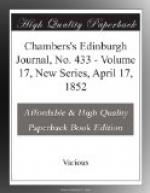Owing to our constant intercourse with India, there are few among us who are unacquainted with the word ayah. Some who live in London or its neighbourhood may perhaps have occasionally met with one of these sable guardian spirits, conducting one or more pale, precocious-looking little children to their British friends; or they may even have fallen in with a group of the tribe in Kensington Gardens, or other public promenades, escorting their little babas, and herding together, like birds of a feather, attracted by the bonds and recollections of colour, climate, caste, and language.
Ayah, in the mouth of a lisping baby, is one of the prettiest words of the East, and is learned as soon as papa and mamma, being equally easy of articulation. The origin of the word is probably either Portuguese or Spanish (aya), although it has now become common to all classes, Christians, Mohammedans, and Hindoos alike. The Hindostanee word for nurse is m[=a]m[)a]-jee, or daee; the Bengalee, doodoo, or dye.
[Transcriber’s Note: Two diacritical marks are found above the letter “a” in the word “mama-jee” in the previous sentence. They are a macron diacritic, a dash-shaped symbol and a breve diacritic, a u-shaped symbol. These letters are indicated here by the coding [=a] for a macron and [)a] for a breve above the letter “a".]
The ayah is frequently a fixture of long standing in a family, descending from mother to daughter; and when this is the case, she is no doubt a valuable possession, and is consulted in all the momentous matters connected with the nursery. However, at the birth of the first baby, she is of course spick-and-span new; and in comes the dusky stranger, all pride and expectation, all hope and joy. It is fortunate that there is no difference in young babies—that the one is as ugly a little thing as the other—and so she is not disappointed: on the contrary, she sees with one glance of her dark glittering eyes, which have their source of sensation in her woman’s heart, a thousand charms that distinguish her baba from all the other babies in the universe. With something akin to a mother’s feelings, she takes the infant in her arms, which seems incontinent to become a part of herself, lying all day on her knees, and sleeping all night in her bosom; and from that moment the nurse, the child, and the paun-box are always together.
As the ayah is exclusively attached to the nursery, and has nothing to do with household affairs or the laying out of money, she is generally a favourite with the other servants, who seem to look upon her as holding an intermediate station between them and the mistress. Should any of them require leave of absence, for the purpose of attending a funeral or a wedding, he applies first to the ayah; or if a little tea is wanted for a sick wife or mother, through her also he obtains the simple, though to him expensive,




